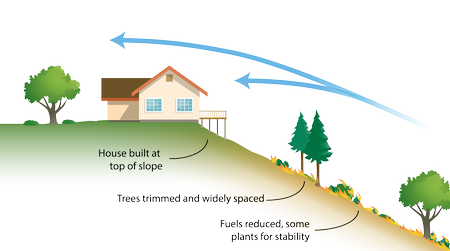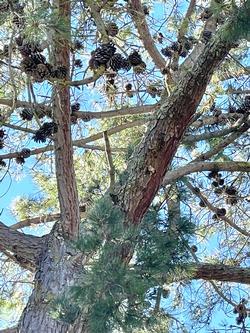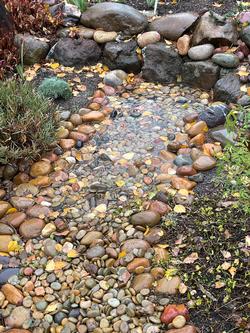Winter 2024
Living in Wildfire Country: Winter Calm and Winter Tasks
By Marilyn Saarni

Planting trees: Winter is bare-root season, and you may be thinking of adding trees to your landscape. If a tree comes bare root, it’s deciduous—so it’s a better choice for a firewise garden right away. However, spacing your trees appropriately is critical. Keep these concepts in mind as you select trees and choose sites.
What is the mature size of your tree? Make sure there’s sufficient clearance between the mature canopy of your new tree and flammable structures (sheds and wood fencing), and other trees—on level ground that’s typically 10 feet minimum. Do take a tape measure out! To visualize, you can estimate by thinking, “Two stories high and two cars wide is a tree that’s 20 feet tall and 30 feet wide.” That is, a building story is 8-10 feet, and a Honda CRV is 15 feet long. You can cluster trees, but then you need to provide a substantial gap between grouped canopies. If you’re planting trees downhill from your home, you need to do more research.
The general recommendation is to plant at least 50 feet downhill, making sure the new tree will be trained and maintained to ensure flames will travel below the canopy, not climb into the canopy. A tall grass understory fire traveling up a 45° slope can easily generate 10-foot-tall flames. A backyard orchard is an exception. In most cases, if you site your backyard orchard canopy edge (that is, the cluster of canopies) at least 10 feet from your house or flammable structures, you can manage that little orchard fairly well to reduce wildfire risk. Since backyard orchard trees typically branch low to the ground, plan on a ground cover that is less than 3 inches for the understory, or use rock or compost mulch—no tall perennials here! Any tree within Defensible Zone 1 (5-30 feet from flammable structures) should be firewise—deciduous, fleshy and moist leaves, low volatile oil content, smooth bark, and low litter habit. Of native tree species, the riparian zone deciduous trees—dogwoods, maples, and alders—are often excellent choices. While a few of them require moderate water, several are surprisingly summer-drought resistant once established.
Pruning and training young trees: When leaves have dropped, you can easily see the structure of your young tree. This is when you can cut out the crossing branches, dead bits, and inward-growing branches that make the tree dense. Open structures are more likely to let embers blow through without catching fire. Really young trees—1-5 years in the ground, with trunks less than 2 inches in diameter at chest height—often benefit from letting some of the lower branchlets remain, removing them only when the branches approach 1-inch thickness. (I like the “remove when it’s ring-finger thick” mnemonic.) The leaves of these lower branches feed the trunk structure so it’s thicker and stronger, and more resilient in stormy and windy weather. Nor do you ever want to remove more than a third of a tree’s canopy. As trees reach 8-10 feet, generally you can remove the low branches, as the trunk’s structure is firmly set by then. By the time the tree is 12 feet tall, you can work up to removing limbs up to 6 feet—or open up the framework so there are no leaves in that lower area. This approach works beautifully for tulip magnolia, ‘Magnolia soulangeana’ and fig, ‘Ficus carica’ trees, with their beautiful multi-trunk habits.

Add sheet mulch and rock to control weeds and create mini-firebreaks: At this time of the year, the first weeds are showing up. You can create more paths or mini-firebreaks, or control those weeds under trees and shrubs when you lay down cardboard first. Try using packaging from appliance stores—usually plain natural cardboard with less tape to remove and more efficiency to overlap and cover larger areas. There is no need to weed first, except to pull out bulky things to make it easier to lay down the cardboard. Fix the cardboard with landscape staples—use longer staples for slopes. Then put 3-4 inches of gravel on top, or compost, in Defensible Zone 0 or 1. (You absolutely will need 3-4 inches minimum to control weeds.) For steadier footing, you can use pavers that interlock or larger stepping stones nested on top of gravel. Gravel with a diameter of 1.25 inches or more is more likely to stay in place when using an electric leaf blower.

Making an older garden firewise is hard work. If you are converting a fire-prone landscape (those 1960s junipers, other conifers, risky foundation plantings, long hedges, and so forth), know that it takes time and can be emotionally trying. Most of us have homes and gardens that were built before the 2008 Wildfire Resilient Building Codes went into effect and before awareness of the increasing wildfire risk became critical. Be patient with your efforts. Every action advances you toward your goal of a safer garden. Consider establishing a Firewise Neighborhood, which allows you and your neighbors to seek grants. See if you and your neighbors can get together and take advantage of Contra Costa’s Measure X Wildfire Mitigation Assistance programs. Enjoy those serendipitous moments as you convert your new garden—you’ll experience delightful opportunities for creative design and problem solving, and learn about the many charming and colorful firewise plants.
References
2008 Wildfire Resilient Building Codes
The Effects of Mandatory Investment in Wildfire Resilience
